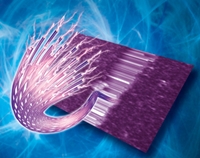Self-assembling highly conductive plastic nanofibres
23 Apr 2012
Researchers from CNRS and the Université de Strasbourg, headed by Nicolas Giuseppone and Bernard Doudin, have succeeded in making highly conductive plastic fibres that are only several nanometres thick. These nanowires, for which CNRS has filed a patent, ''self-assemble'' when triggered by a flash of light. Inexpensive and easy to handle, unlike carbon nanotubes, they combine the advantages of the two materials currently used to conduct electric current: metals and plastic organic polymers.
 In fact, their remarkable electrical properties are similar to those of metals. In addition, they are light and flexible like plastics, which opens up the possibility of meeting one of the most important challenges of 21st century electronics: miniaturising components down to the nanometric scale. This work will be published on 22 April 2012 on Nature Chemistry's website. The next step is to demonstrate that these fibres can be industrially integrated within electronic devices such as flexible screens, solar cells, etc.
In fact, their remarkable electrical properties are similar to those of metals. In addition, they are light and flexible like plastics, which opens up the possibility of meeting one of the most important challenges of 21st century electronics: miniaturising components down to the nanometric scale. This work will be published on 22 April 2012 on Nature Chemistry's website. The next step is to demonstrate that these fibres can be industrially integrated within electronic devices such as flexible screens, solar cells, etc.
In previous work published in 20105, Giuseppone and his colleagues succeeded for the first time in obtaining nanowires. To achieve this feat, they chemically modified ''triarylamines'', synthetic molecules that have been used for decades by industry in Xerox photocopying processes. Much to their surprise, they observed that in light and in solution, their new molecules stacked up spontaneously in a regular manner to form miniature fibres. These wires, a few hundred nanometres long (1 nm = 10-9 m, i.e. a billionth of a meter), are made up of what is known as the ''supramolecular'' assembly of several thousand molecules.
In collaboration with Doudin's team, the researchers then studied the electrical properties of these nanofibers in detail. This time, they placed their molecules in contact with an electronic microcircuit comprising gold electrodes spaced 100 nm apart. They then applied an electric field between these electrodes.
Their first important finding was that, when triggered by a flash of light, the fibers self-assemble solely between the electrodes. The second surprising result was that these structures, which are as light and flexible as plastics, turn out to be capable of transporting extraordinary current densities, above 2.106 Amperes per square centimeter (A.cm-2), approaching those of copper wire. In addition, they have very low interface resistance with metals: 10,000 times below that of the best organic polymers.
The researchers now hope to demonstrate that their fibers can be used industrially in miniaturized electronic devices such as flexible screens, solar cells, transistors, printed nanocircuits, etc.













.jpg)






.jpg)









